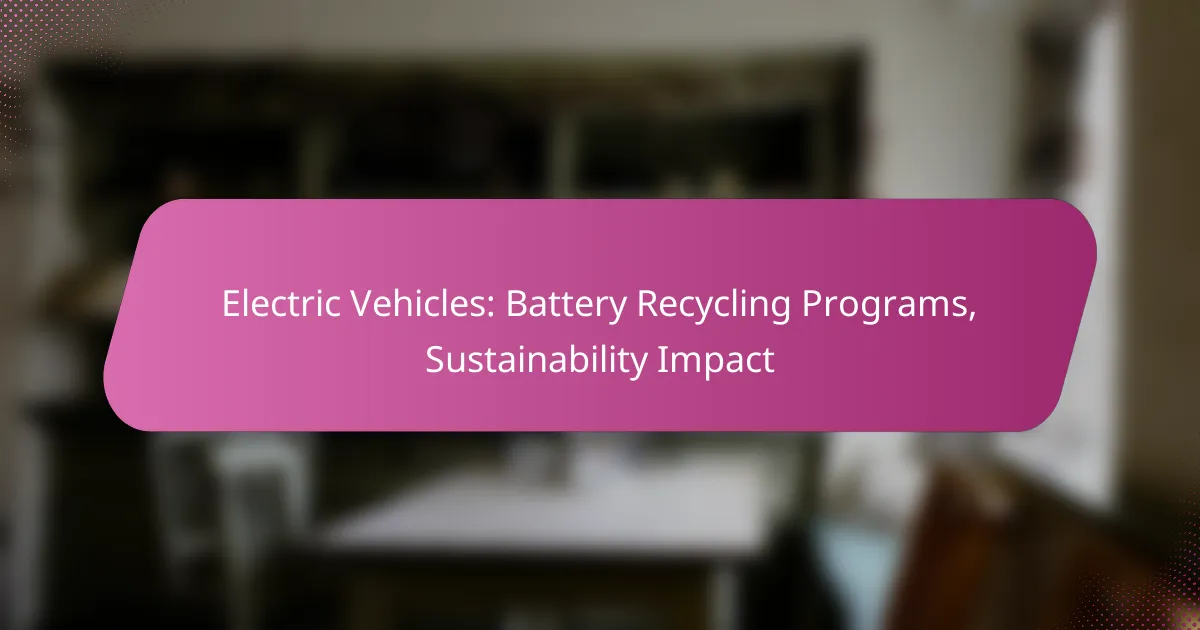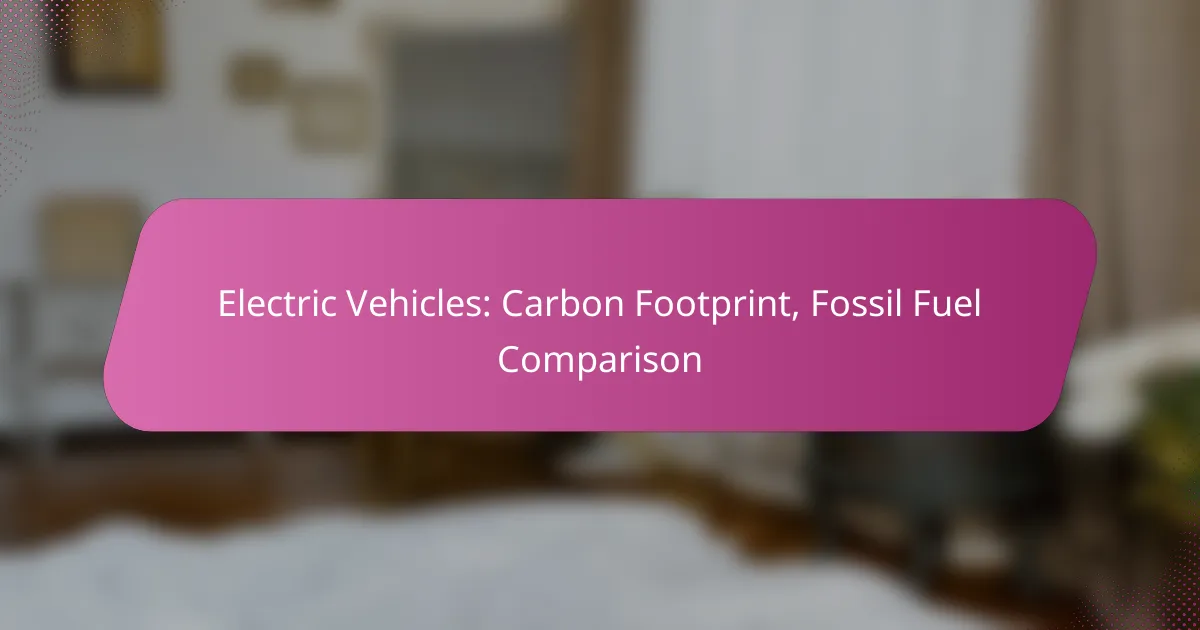Battery recycling programs for electric vehicles are essential for promoting sustainability and reducing environmental impact. By effectively managing the lifecycle of batteries, these initiatives conserve natural resources and provide economic benefits to manufacturers. Collaboration among stakeholders ensures that valuable materials are reused, minimizing waste and supporting the growth of the electric vehicle market.

What are the benefits of battery recycling programs for electric vehicles?
Battery recycling programs for electric vehicles provide significant benefits, including reduced environmental impact, conservation of natural resources, and economic advantages for manufacturers. These programs help to manage the lifecycle of batteries effectively, ensuring that valuable materials are reused and minimizing waste.
Reduction of environmental impact
Recycling electric vehicle batteries significantly lowers the environmental footprint associated with battery disposal. By recovering materials like lithium, cobalt, and nickel, recycling reduces the need for mining, which can cause habitat destruction and pollution.
Moreover, proper recycling processes prevent hazardous materials from entering landfills, thus protecting soil and water resources. This contributes to a cleaner ecosystem and supports sustainability efforts in the automotive industry.
Conservation of natural resources
Battery recycling plays a crucial role in conserving natural resources by reclaiming valuable metals and materials. For instance, recycling can recover up to 95% of lithium and cobalt from used batteries, which are essential for new battery production.
This conservation reduces reliance on virgin materials, helping to maintain resource availability for future generations. It also mitigates the environmental impact of mining operations, which are often resource-intensive and damaging.
Economic advantages for manufacturers
Manufacturers benefit economically from battery recycling programs through reduced material costs. By sourcing recycled materials, companies can lower their production expenses and potentially pass savings on to consumers.
Additionally, recycling initiatives can create a more stable supply chain for critical materials, protecting manufacturers from price volatility in the raw materials market. This stability can enhance competitiveness in the growing electric vehicle sector.
Job creation in recycling sectors
Battery recycling programs contribute to job creation within the recycling and waste management sectors. As demand for electric vehicles increases, so does the need for efficient recycling operations, leading to new employment opportunities.
These jobs range from collection and transportation to processing and refining of battery materials. Investing in recycling infrastructure not only supports the economy but also promotes sustainable practices in the automotive industry.
Improved battery life cycle management
Effective battery recycling programs enhance life cycle management by ensuring that batteries are disposed of responsibly and efficiently. This management includes tracking battery usage, performance, and eventual recycling, which can inform future designs and manufacturing processes.
By understanding the life cycle of batteries, manufacturers can improve product durability and recyclability, leading to better overall sustainability in electric vehicle production. This approach aligns with global efforts to reduce waste and promote circular economy principles.
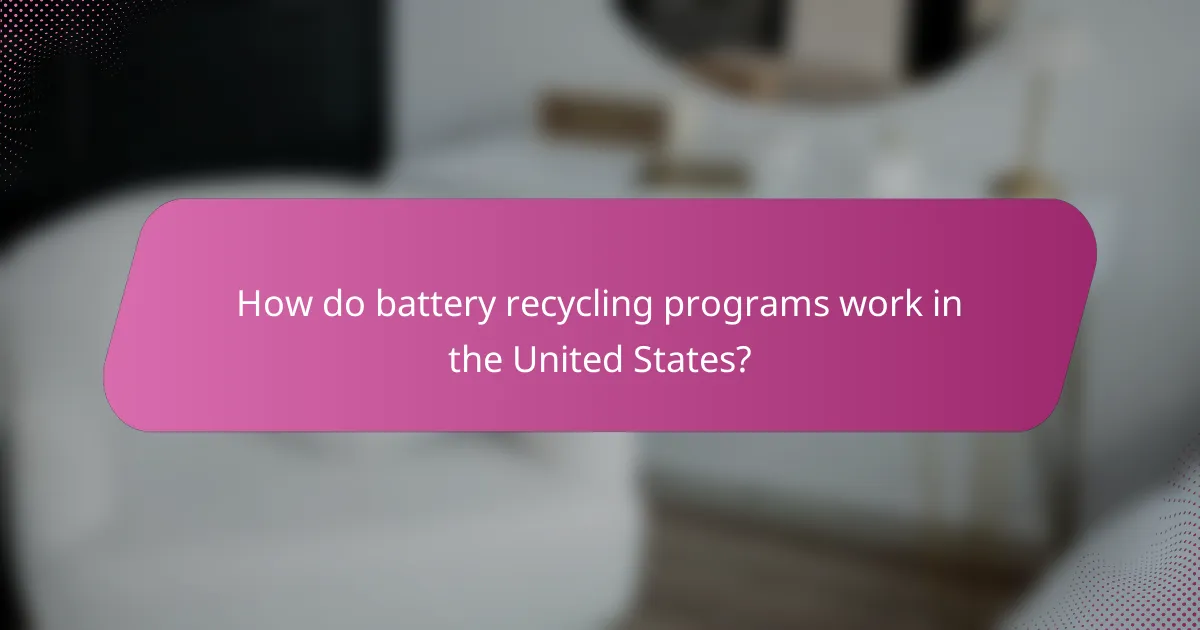
How do battery recycling programs work in the United States?
Battery recycling programs in the United States focus on collecting, processing, and reusing materials from spent batteries to minimize environmental impact and recover valuable resources. These programs involve collaboration between manufacturers, consumers, and recycling facilities to ensure efficient and sustainable practices.
Collection and transportation processes
The collection of used batteries typically occurs through designated drop-off locations, retail take-back programs, and municipal collection events. Consumers can often find collection bins at electronics retailers or local recycling centers, making it convenient to dispose of batteries responsibly.
Transportation of collected batteries to recycling facilities is crucial to prevent leakage of hazardous materials. Many states require that batteries be transported in compliance with specific regulations to ensure safety and environmental protection during transit.
Recycling technologies used
Recycling technologies for batteries vary depending on the battery type, with common methods including pyrometallurgical and hydrometallurgical processes. Pyrometallurgical recycling involves high-temperature smelting to recover metals, while hydrometallurgical methods use chemical solutions to extract valuable materials.
Some facilities are also exploring advanced techniques such as direct recycling, which aims to preserve the battery’s structure and improve the efficiency of material recovery. These technologies enhance the sustainability of battery recycling by reducing energy consumption and waste generation.
Regulatory frameworks governing recycling
In the United States, battery recycling is governed by a mix of federal and state regulations. The Resource Conservation and Recovery Act (RCRA) sets standards for hazardous waste management, including certain types of batteries. Additionally, many states have enacted laws requiring manufacturers to implement take-back programs.
Compliance with these regulations ensures that recycling processes are safe and effective. Companies involved in battery recycling must stay updated on local laws, as requirements can vary significantly from one state to another, affecting how they operate and manage waste.

What are the leading battery recycling companies in North America?
The leading battery recycling companies in North America focus on sustainable practices to recover valuable materials from used batteries. These companies play a crucial role in reducing environmental impact and supporting the growing electric vehicle market.
Li-Cycle
Li-Cycle specializes in lithium-ion battery recycling, utilizing a unique hydrometallurgical process to recover up to 95% of battery materials. Their facilities are designed to handle various battery types, ensuring efficient processing and minimal waste.
With operations in Canada and the United States, Li-Cycle is positioned to meet the increasing demand for battery recycling as electric vehicle adoption rises. Their commitment to sustainability includes reducing greenhouse gas emissions and promoting a circular economy.
Redwood Materials
Redwood Materials focuses on recycling lithium-ion batteries and recovering essential materials like lithium, nickel, and cobalt. Their innovative processes aim to create a closed-loop supply chain for battery components, significantly reducing the need for new mining.
Based in Nevada, Redwood Materials collaborates with major electric vehicle manufacturers to ensure a steady supply of recycled materials. Their efforts contribute to lowering production costs and enhancing the sustainability of battery manufacturing.
American Battery Technology Company
American Battery Technology Company (ABTC) is dedicated to developing advanced recycling technologies for lithium-ion batteries. Their approach emphasizes the recovery of critical materials while minimizing environmental impact through efficient processing techniques.
ABTC operates in the United States and aims to support the domestic supply chain for battery materials. By focusing on sustainable practices, they help reduce reliance on foreign sources and promote a greener future for electric vehicle production.
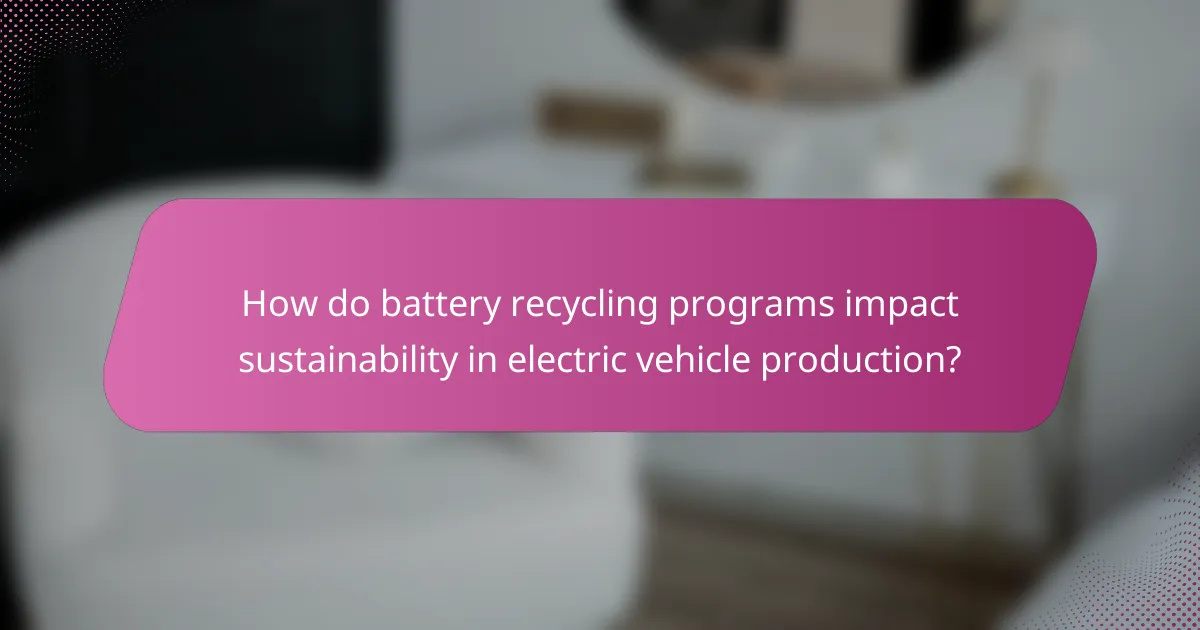
How do battery recycling programs impact sustainability in electric vehicle production?
Battery recycling programs significantly enhance sustainability in electric vehicle (EV) production by reducing waste and conserving resources. These initiatives ensure that valuable materials are recovered and reused, minimizing the environmental impact associated with mining and manufacturing new batteries.
Reduction of carbon footprint
Battery recycling programs contribute to a lower carbon footprint by decreasing the need for raw material extraction, which is often energy-intensive. For instance, recycling lithium, cobalt, and nickel can reduce greenhouse gas emissions by a notable percentage compared to sourcing these materials from mines.
Additionally, the energy required to process recycled materials is generally less than that needed for new materials. This reduction not only helps in cutting emissions but also supports the transition to a more sustainable energy system.
Enhancement of circular economy practices
Battery recycling is a key component of circular economy practices, where materials are kept in use for as long as possible. By recycling EV batteries, manufacturers can reclaim essential metals and components, which can then be reintegrated into the production cycle.
Implementing these practices encourages manufacturers to design batteries with recyclability in mind, fostering innovation and efficiency. For example, companies are increasingly adopting modular designs that simplify disassembly and material recovery, further supporting sustainability goals.
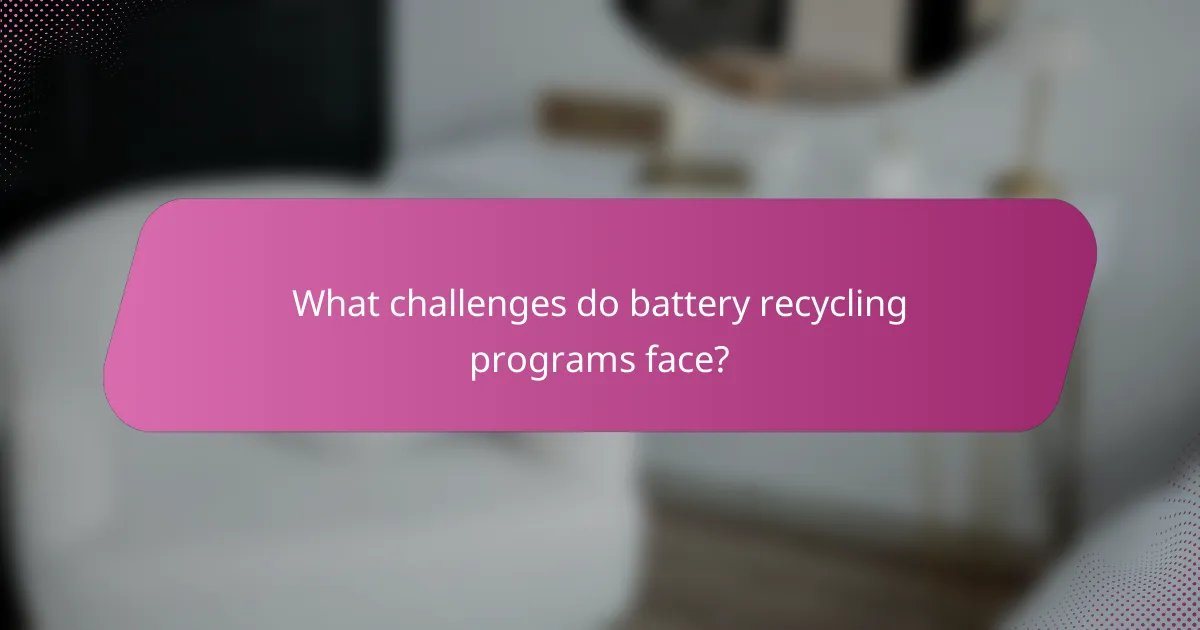
What challenges do battery recycling programs face?
Battery recycling programs encounter several significant challenges that hinder their effectiveness and efficiency. Key issues include technological limitations and the high costs associated with recycling processes, both of which impact the overall sustainability of electric vehicle batteries.
Technological limitations
Technological limitations in battery recycling refer to the current inability to efficiently recover all valuable materials from used batteries. Many existing methods can only extract a fraction of the metals, such as lithium, cobalt, and nickel, which are crucial for new battery production.
Moreover, the complexity of battery designs, especially in electric vehicles, complicates the recycling process. Different battery chemistries require tailored recycling techniques, which are not yet widely available or standardized across the industry.
High costs of recycling processes
The high costs of recycling processes present a significant barrier to the widespread adoption of battery recycling programs. The expenses involved in collecting, transporting, and processing batteries can be substantial, often exceeding the value of the recovered materials.
Additionally, investments in advanced recycling technologies are necessary to improve efficiency and recovery rates. However, these investments can be daunting for many companies, especially smaller firms, limiting their ability to participate in sustainable practices.
